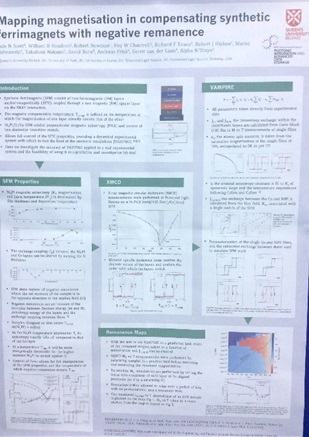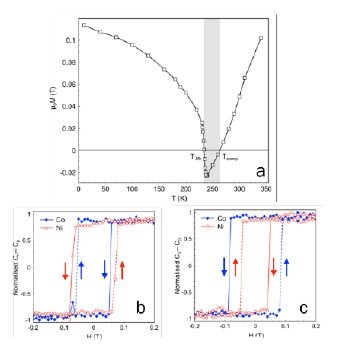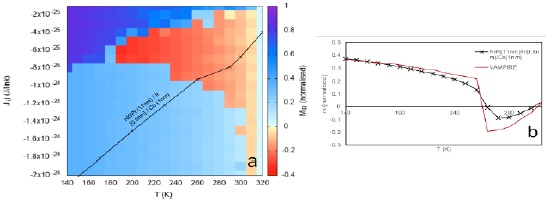
Mapping magnetisation in compensating synthetic ferrimagnets with negative remanence
J. Scott, W. Hendren, R. Bowman, R. Chantrell, R. Evans, R. Hicken, M. Dabrowski, T. Nakano, D.M. Burn, A. Frisk, G. van der Laan and A. N’Diaye
IoP Magnetism Leeds Apr 2019
Synthetic ferrimagnets (SFM), two ferromagnetic layers exchange-coupled via the RKKY interaction across a nonmagnetic spacer layer, are of particular interest as a feasible media for all optical magnetic switching [1,2]. The atomistic simulation package, VAMPIRE [3], is used in conjunction with SQUID magnetometry and x-ray magnetic circular dichroism (XMCD), to characterise a series of perpendicular, compensating Ni3Pt/Ir/Co SFMs, fabricated by magnetron sputtering. Designing and creating these structures requires knowledge and control of several fundamental magnetic parameters, the magnetisation with temperature, M(T) and the anisotropy, K(T), of the individual ferromagnetic layers and the exchange interaction between them, Jij.
Unexpectedly, these Ni3Pt/Ir/Co SFM exhibit regions of negative remanent magnetisation, MR, observed in experiment and replicated in simulation, just below the compensation point, Tcomp.This can be described as an interplay between anisotropy, exchange and Zeeman energies of the system [4]. XMCD measurements confirm the distinct nature of SFM layers and the negative MR, Fig 1.
VAMPIRE is used to successfully reproduce the main features of the magnetic behaviour and yield insights to the magnetisation dynamics on the atomic scale. The simulations can be presented as a map of the MR dependence on Jij and T so creating a ‘phase diagram’ (Fig 2), revealing the regions of distinct magnetic behaviour, for a particular SFM. This further demonstrates the ability of VAMPIRE to elucidate and enhance new synthetic material development.

Fig 1: Ni3Pt(8.5nm)/Ir(0.5nm)/Co(1nm) (a) SQUID measurement of MR vs T, (b) XMCD at T < T-Mr, Tcomp, (c) XMCD at T-Mr < T < Tcomp

Fig 2: (a) VAMPIRE phase map of Ni3Pt(11nm)/Ir(0.5nm)/Co(1nm) of MR as a function of Jij and T. The red regions mark the point at which the Ni3Pt is the first layer to reverse. Below Tcomp, the higher moment of the Ni3Pt layer results in negative MR. The black line marks the experimental Jij vs T of a Ni3Pt(11nm)/Ir(0.5nm)/Co(1nm) SFM calculated from minor loops (b) MR vs T cross section of the data plotted on the VAMPIRE remanence map compared to that measured via SQUID
- S. Mangin et al, Nature Materials 13, 286 (2014)
- R. F. L. Evans et al, Appl. Phys. Lett. 104, 082410 (2014)
- R. F. L. Evans et al, J. Phys.: Condens. Matter 26, 103202 (2014)
- K. Takanashi et al, Appl. Phys. Lett. 63, 1585 (1993)